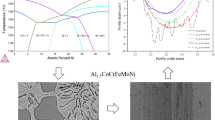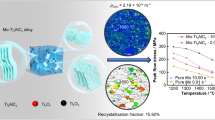A method is presented to obtain a thermodynamic description of a multicomponent alloy system in terms of a pseudo-ternary formalism. In the present study, this method was applied to multicomponent Ti64 alloys with the “6” and “4” denoting the nominal 6 wt.% of Al and 4 wt.% of V in this class of Ti alloys. However these alloys, in practice, contain many other alloying elements such as O, C N, Fe, and H which exhibit appreciable effect on the thermodynamic properties of Ti64. The essence of this approach is to treat the multicomponent alloys as a pseudo-ternary Ti-Al x -V y , in which the apparent composition of Al x is the weighted summation of that of Al and those of the α-stabilizers in minor quantities such as O, C and N and that of V y is the weighted summation of that of V and those of the β stabilizing minor elements such as Fe and H. Three Ti64 alloys with slightly different chemistries were treated as pseudo-ternary alloys, and the β transus and β (and α) approach curves were calculated using this pseudo-ternary thermodynamic description. The calculated results were found to compare favorably with those calculated from a multicomponent thermodynamic database for titanium alloys. This study demonstrates that such a simplified thermodynamic description, when available, can be readily coupled with kinetic models for engineering applications. One example is to predict microstructure evolution of a multicomponent alloy when subjected to a specific heat treatment condition.





Similar content being viewed by others
References
Wang Y., Ma N., Chen Q., Zhang F., Chen S.L., Chang Y.A. (2005) JOM 57(9):32-39
Y. Wang, L.Q. Chen, and A.G. Khachaturyan, Computer Simulation in Materials Science Nano/Meso/Macroscopic Space and Time Scales, Kluwer Academic Publishers, 1996
Y. Wang and L.Q. Chen, Simulation of Microstructural Evolution Using the Field Method, John Wiley & Sons. Inc., 2000
A. Karma, Phase-Field Methods, Elsevier, Oxford, 2001
Chen L.Q. (2002) Annu. Rev. Mater. Res 32:113
C. Shen, J.P. Simmons, K. Wu, and Y. Wang, Materials Design Approaches and Experiences, TMS, 2001, p 57-74
Chen Q., Ma N., Wu K., Wang Y. (2004) Scripta Mater. 50:471-476
Ma N., Kazaryan A., Dregia S.A., Wang Y. (2004) Acta Mater. 52:3869
B. Wang et al., in preparation (2006)
Ansara I. (1979) Int. Metals Rev. 24:20-53
Sundman B., Agren J.(1981) J. Phys. Chem. Solids 42:297-301
R. Boyer, G. Welsch, and E.W. Collings (Eds.), Materials Properties Handbook: Titanium Alloys, ASM International, Materials Park, OH 44073-0002, 1994
R. Boyer, Private communication (2006)
Chen S.L., Zhang F., Daniel S., Xie F.-Y., Yan X.-Y., Chang Y.A., Schmid-Fetzer R., Oates W.A. (2003) JOM 55(12):48-51
Zhang F., Xie F.-Y., Chen S.-L., Chang Y.A., Furrer D., Venkatesh V. (2005) J. Mater. Engineer. Perform. 14(6):717-721
Semiatin S.L., Montheillet F., Shen G., Jonas J.J. (2002) Metall. Mater. Trans. A 33(8):2719-2727
D. Furrer, Private Communication, 2004
Castro R., Seraphin L. (1966) Mem. Sci. Rev. Met. 63:1025-1058
Acknowledgments
We would like to acknowledge the support of AFRL through the Metals Affordability Initiative under contract F33615-99-2-5215, which was lead by Dr. D. Furrer of Ladish Co., Inc., and the support of AFRL through SBIR project under contract F33615-01-C-5208. We like to thank in particular Dr. J. Simmons for his support and interest in this work. We would also like to thank R. Boyer for his help in understanding the equivalent factors.
Author information
Authors and Affiliations
Corresponding author
Rights and permissions
About this article
Cite this article
Zhang, F., Chen, SL., Chang, Y. et al. Development of Thermodynamic Description of a Pseudo-Ternary System for Multicomponent Ti64 Alloy. J Phs Eqil and Diff 28, 115–120 (2007). https://doi.org/10.1007/s11669-006-9006-5
Received:
Published:
Issue Date:
DOI: https://doi.org/10.1007/s11669-006-9006-5




